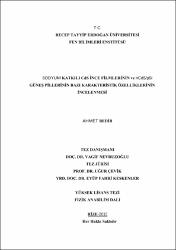| dc.contributor.author | Bedir, Ahmet | |
| dc.date.accessioned | 2019-09-24T10:21:10Z | |
| dc.date.available | 2019-09-24T10:21:10Z | |
| dc.date.issued | 2015 | |
| dc.identifier.uri | https://hdl.handle.net/11436/420 | |
| dc.description.abstract | Bu çalışmada, II–VI yarıiletken grubuna ait CdS ince filmlerine ve nCdS/pSi güneş pillerine sodyum katkısının etkisi incelendi. İlk önce CdS ince filmleri kimyasal banyo yöntemiyle cam altlıklar üzerinde üretildi. Bu filmlerin yapısal, elektriksel ve optiksel özellikleri araştırıldı. CdS filmlerin kalınlığı yaklaşık olarak 140 nm olduğu belirlendi. X-ışını kırınım desenleri hegzagonal faza ait düzlemlerden yansımalar gösterdi. Artan sodyum katkısı ile örneklerin tane boyutunun 6,20 nm'den 4,09 nm'ye doğru azaldığı hesaplandı. Sodyum katkısı ile örneklerin optik geçirgenliğinde artışlar görüldü. Farklı sodyum yoğunluklarında üretilen CdS örneklerinin optik soğurma spektrumlarından elde edilen yasak band aralıklarının 2,62 eV'dan 2,88 eV'a doğru arttığı tespit edildi. Sodyum katkısı ile örneklerin özdirenci artarken taşıyıcı yoğunluğunun ve elektron hareketliliğinin azaldığı tespit edildi. Çalışmanın ikinci aşamasında farklı yoğunluklarda sodyum içeren nCdS ince filmleri pSi tek kristal yüzeyine kimyasal banyo yöntemiyle çöktürülerek nCdS/pSi ikili yapıları üretildi. Elde edilen ikili yapının fotovoltaik parametreleri 93 mW/cm2 aydınlatma gücünde olan yapay güneş ışını altında incelendi. Sodyum katkılı nCdS/pSi heterogeçitlerin temas bölgesinde oluşan Na2SiO3 fazı tespit edildi ve bu fazın akım mekanizmasına olan etkileri araştırıldı. In this study, the effect of the doping sodium on the CdS thin films, which are in II-VI group semiconductor, was investigated. CdS thin films were prepared on glass substrates by chemical bath deposition technique. The structural, electrical and optical properties of these thin films were investigated. The thickness of the CdS film was determined approximately 140 nm. X-ray diffraction pattern showed reflections in the plane of the hegzogonal phase. The samples were calculated by increasing the particle size of sodium dopping with reduce from 6,20 to 4,09 nm. It was observed that the optical transparency of the samples increases with sodium doping. It was detected that band gap energy which is obtained by the optical absorption spectra of CdS samples in different sodium density increases from 2,62 eV to 2,88 eV. It was found that resistivity of the samples increases with sodium contribution of decreased carrier density and electron mobility. In the second phase of the study, nCdS thin films containing different concentrations of sodium on single crystal surface by CBD method and the result of these nCdS/pSi solar cells were produced. The photovoltaic parameters of the resulting binary structure were investigated under 93 mW / cm2 power lighting of artificial sun's ray It was detected Na2SiO3 phase on contact region of sodium doping nCdS/pSi hetero structure and investigated their impact on current mechanisms. | en_US |
| dc.language.iso | tur | en_US |
| dc.publisher | Recep Tayyip Erdoğan Üniversitesi / Fen Bilimleri Enstitüsü / Fizik Anabilim Dalı | en_US |
| dc.rights | info:eu-repo/semantics/openAccess | en_US |
| dc.subject | 0-Belirlenecek | en_US |
| dc.title | Sodyum katkili Cds i̇nce filmlerinin ve nCdS/pSi güneş pillerinin bazi karakteristik özelliklerinin i̇ncelenmesi | en_US |
| dc.title.alternative | The Investigation of Some Characteristic Properties of Sodium Doped Cds Thin Films and nCdS/pSi Solar Cells | en_US |
| dc.type | masterThesis | en_US |
| dc.contributor.department | 0-Belirlenecek | en_US |
| dc.contributor.institutionauthor | Bedir, Ahmet | |
| dc.relation.publicationcategory | Tez | en_US |


















